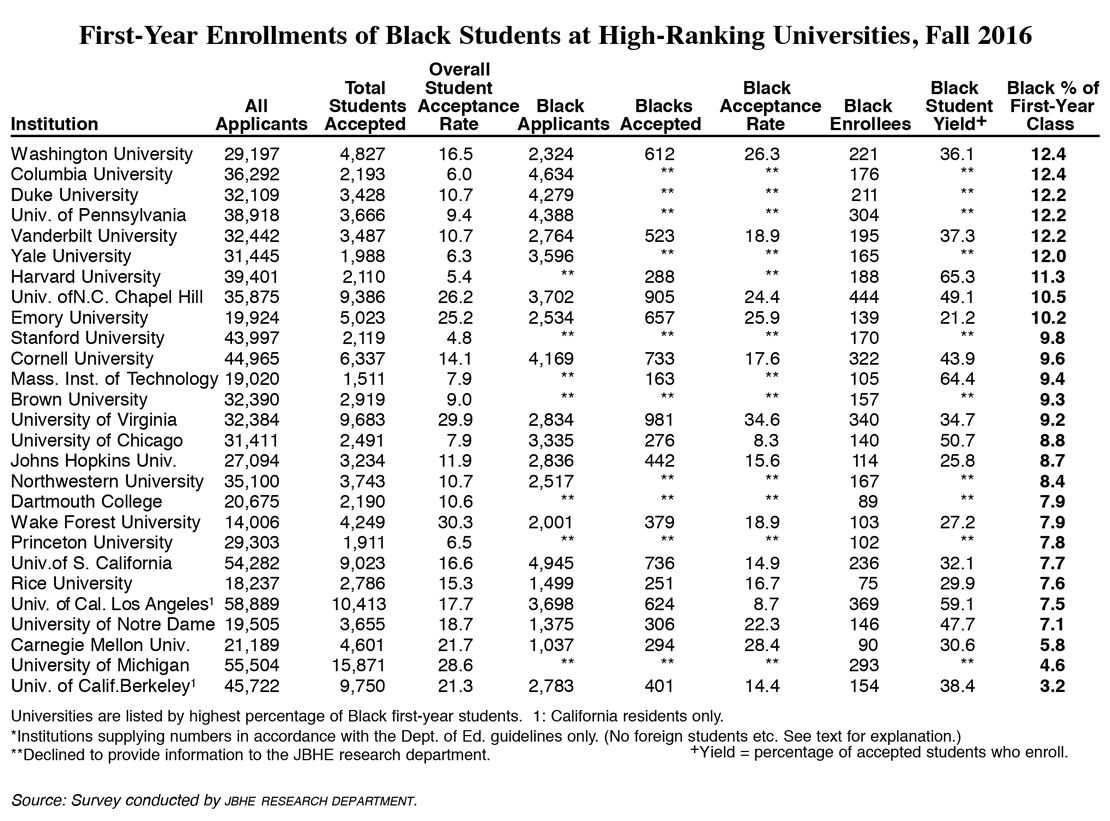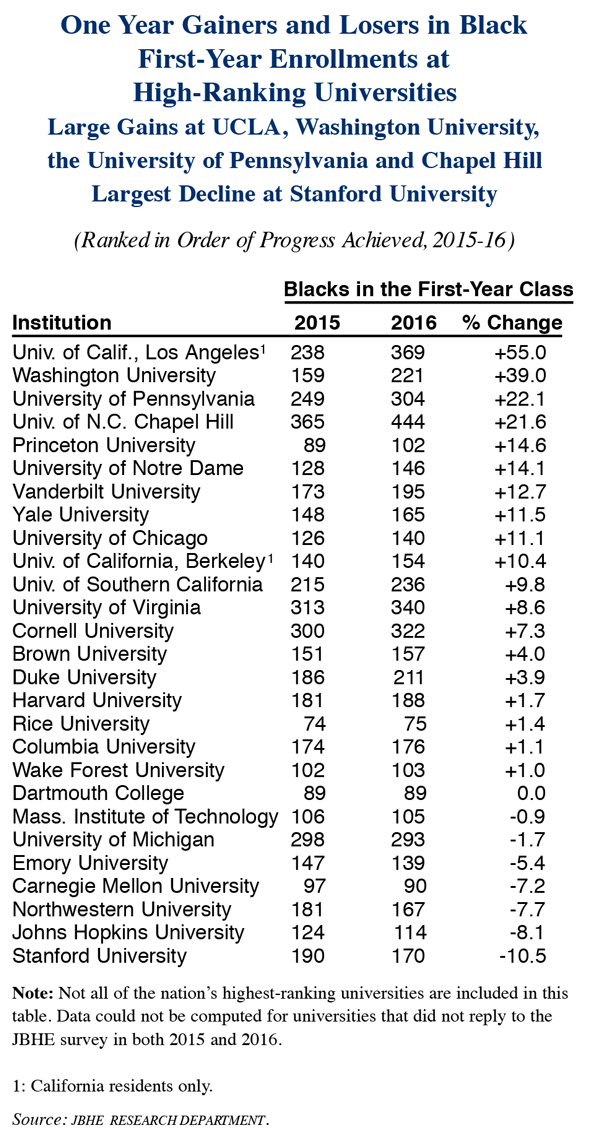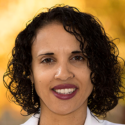![]() Once more, this year The Journal of Blacks in Higher Education has completed its survey of admissions offices at the nation’s highest-ranked research universities. For the 24th consecutive year, we have calculated and compared the percentages of Black/African-American students in this fall’s entering classes. As in the past, our survey publishes information on the total number of Black applicants at the various institutions, their acceptance rates, enrollment numbers, and yield rates (the percentage of students who eventually enroll in the colleges at which they were accepted).
Once more, this year The Journal of Blacks in Higher Education has completed its survey of admissions offices at the nation’s highest-ranked research universities. For the 24th consecutive year, we have calculated and compared the percentages of Black/African-American students in this fall’s entering classes. As in the past, our survey publishes information on the total number of Black applicants at the various institutions, their acceptance rates, enrollment numbers, and yield rates (the percentage of students who eventually enroll in the colleges at which they were accepted).

Only 12 years ago in 2004, Blacks made up only 6.8 percent of the entering students at Columbia University. Columbia ranked 15th among the high-ranking research universities in our survey. Just three years later in 2007, Columbia University headed the JBHE rankings for the first time with the entering class that was 11.4 percent Black. In 2010, there were 202 Black first-year students at Columbia. They made up 14.5 percent of the incoming students. This was the highest percentage of Black students in the entering class at a leading research university in the history of the JBHE survey. For nine years in a row, Columbia had the highest percentage of Black first-year students among the 30 highest-ranking universities in the nation. Last year, Black students were 14.1 percent of the students in the entering class at Columbia.
This year, there are 176 Black students in the entering class at Columbia. They make up 12.4 percent of the entering class. At Washington University in St. Louis, there are 221 students in the first-year, also making up 12.4 percent of the entering class. But if we further refine the statistics, we find that Blacks make up 12.43 percent of the entering class at Washington University and 12.39 percent of the entering class at Columbia. So technically, Washington University ranks in first place by the smallest of margins.
Two years ago, there were 84 Black students in the entering class at Washington University. They made up 4.8 percent of the entering class. Only two high-ranking research universities had a lower percentage of Black students in their first-year classes. By 2015, there were 159 Black students in the entering class, making up 9.2 percent of all first-year students. At that time admissions officials told JBHE that “our number is still relatively small and we hope to continue to make progress as our efforts expand further.” They have made good on that promise. This year, there are 221 Black students in the entering class, making up 12.4 percent of all first-year students. Over the two-year period, the number of Black students in the entering class at Washington University rose from 89 to 221, a 148 percent increase.
Duke University in Durham, North Carolina, the University of Pennsylvania, and Vanderbilt University in Nashville, Tennessee, tied for third place in our survey with entering classes that are 12.2 percent Black. A year ago these three universities had entering classes that were between 10.2 and 10.8 percent Black.
At Duke University the number of Black students and the percentage of Black students in the entering class are both records for the university. Christoph Guttentag, dean of undergraduate admissions at Duke University, told JBHE that he was very pleased with this year’s results but added that “I try not to place too much weight or attention on a single year, regardless of whether the numbers are higher or lower than before. I’m most proud of our ability to consistently enroll a significant number of very talented Black students year in and year out.”
Harvard University has a record high percentage of Black students in its first-year class. Yet it ranks fourth in the Ivy League and seventh overall with an entering class that is 11.3 percent Black.
The progress of the Ivy League school over the past decade in admitting Black students has been impressive. In 2006, Columbia University had the highest percentage of Black first-year students at 9.6 percent. This year five of the eight Ivy League schools had reached the 9.6 percent threshold or higher. A decade ago, the lowest percentage of Blacks in an entering class was 5.9 percent. This year it is 7.8 percent. A decade ago, there were 1,110 Black students in the entering classes at the eight Ivy League schools. In 2016, there are 1,503, a 35 percent increase.
In 2004, only two of the nation’s highest-ranked universities had incoming classes that were more than 10 percent Black. This year there are nine high-ranked universities with an entering class that is more than 10 percent Black. In 2016, six high-ranking universities have an entering class that is at least 12 percent Black. In 2004, there were none. These figures are a major sign of progress for African Americans at our top universities.
The bottom place in our survey belongs to the University of California at Berkeley, which is prohibited by state law from considering race in their admissions decisions. The percentage of Black first-year students at Berkeley remains significantly below the level of Black enrollments that existed before that state enacted a ban on race-sensitive admissions.
Gainers and Losers

This year, 19 of the high-ranking universities that responded to our survey in both 2015 and 2016 showed gains over the previous year in Black student first-year enrollments. Only seven high-ranking universities showed declines in their number of entering students who are Black. The Massachusetts Institute of Technology had the exact same number of Black students in its entering class as it did a year ago.
As stated above, Washington University in St. Louis has achieved tremendous progress in increasing the number of Black students in its entering class. But the largest percentage gain this year was at the University of California, Los Angeles. At UCLA there are 369 Black first-year students from California enrolled at the university. A year ago there were 238. This is a significant increase of 55 percent. It must be noted that admissions decisions by state universities in California must be made without the consideration of race.
The University of Pennsylvania posted a large 22.1 percent increase in Black students in its entering class this year. The University of North Carolina at Chapel Hill was not far behind, with a 21.6 percent increase. Princeton University, the University of Notre Dame, Vanderbilt University, Yale University, the University of Chicago, and the University of California, Berkeley, all posted gains of at least 10 percent. Twelve major research universities posted gains of more than 7 percent in the number of Black students in their entering classes.
Stanford University, was the only major high-ranking research university to post a decline of more than 10 percent in Black students in the first-year class.
A Note on Methodology
Before we continue with the results, it is important to mention how the U.S. Department of Education collects data on the race of undergraduates. Before a change was made several years ago, students who reported more than one race (including African American) were included in the figures for Black students. This is no longer the case. Thus, students who self-identify as biracial or multiracial with some level of African heritage are no longer classified as Black by the Department of Education.
JBHE surveys have always asked respondents to include all students who self-identify as having African American or African heritage including those who are actually from Africa. JBHE has always maintained that biracial, multiracial, and Black students from Africa add to the diversity of a college campus. And including these students in our figures offers college-bound Black students a better idea of what they can expect at a given college or university. In order that we can compare our current data to past JBHE surveys we have continued to asked colleges and universities to include all students who identify themselves as having African American or African heritage.
Black Student Acceptance Rates
It is well recognized that the percentage of Black applicants who actually receive invitations to join the entering class is a valuable gauge of an institution’s commitment to racial diversity. Yet this figure is regarded as the most sensitive of all admissions data. This is particularly true for some of the very highest-ranked institutions.
Of the 27 highest-ranked universities in our survey this year, 12 declined to reveal their Black student acceptance rates. Unquestionably, public and private litigation threats to affirmative action policies in college admissions have been a factor in producing this sensitivity. With this in mind, admissions officers — who on the whole are solidly supportive of affirmative action — have apprehensions when statistics on Black admissions are made available to the public. There are standard concerns too that racial conservatives on faculties and among alumni and trustees may interpret the figures as suggesting a so-called dumbing down of academic standards and a favoring of “unqualified” Blacks over perhaps more qualified Whites.
But, at the same time it is critical to keep in mind that an institution’s high Black acceptance rate often indicates nothing more than the fact that the admissions office of a given institution has a very strong and well-qualified Black applicant pool.
At 10 of the 15 universities that supplied acceptance rate data to JBHE, the Black student acceptance rate was higher than the acceptance rate for all students. In some cases the differences were significant but larger disparities have been seen in prior surveys. Five of the high-ranking universities we surveyed had Black acceptance rates that were in fact lower than the overall acceptance rate. Two of these four are campuses of the University of California that are prohibited by state law from considering race in admissions decisions.
Of the 17 universities that reported Black student yield, the highest rate was at Harvard University. At Harvard, 65.3 all Black students accepted for admission decided to enroll. Among the reporting universities, the Massachusetts Institute of Technology ranked second in Black student yield with a rate of 64.4 percent. UCLA and the University of Chicago were the only other major research universities that reported a Black student yield of more than 50 percent.












Notice the schools in states that bar affirmative action in college admissions (CA,MI) are at the bottom of the list. So it’s safe to assume schools such as Columbia are giving significant preferences to Black students. JHBE’s position is probably that this is good to wrong past discrimination. Yet if the Columbia’s black population is typical of the black population at other top schools about half of the black population is of immigrant background. So even using affirmative action can’t address what is the purported aim of it at its inception, righting past wrongs.
What I find odd is that African American leaders are ok with this conflation by settling for diversity initiatives as opposed to targeted efforts to get the descendants of US slaves more access to top schools.
I can’t speak for African American leaders. But as an advocate for African American access and enrollment at a campus, UCLA, that is prohibited from practicing Affirmative Action, I can tell you that we have not settled. We have engaged the campus and the UC system consistently over the past 10 years, including supporting Supreme Court challenges to California’s Proposition 209. Isolating African American descendants of slaves as well as developing and enacting an admissions process that can increase access for students on that basis is a pretty challenging task. We are always looking for initiatives and plans others have developed. If you have something promising, please share.